
About UsThe Numismatic Bibliomania Society is a non-profit organization promoting numismatic literature. For more information please see our web site at coinbooks.org SubscriptionsThose wishing to become new E-Sylum subscribers (or wishing to Unsubscribe) can go to the following web page link MembershipThere is a membership application available on the web site Membership Application To join, print the application and return it with your check to the address printed on the application. Membership is only $15 to addresses in the U.S., $20 for First Class mail, and $25 elsewhere. For those without web access, write to: David M. Sundman, Secretary/TreasurerNumismatic Bibliomania
Society AsylumFor Asylum mailing address changes and other membership questions, contact David at this email address: dsundman@LittletonCoin.com SubmissionsTo submit items for publication in The E-Sylum, just Reply to this message, or write to the Editor at this address: whomren@coinlibrary.com
BUY THE BOOK BEFORE THE COINYou won't regret it! |
- WAYNE'S WORDS: THE E-SYLUM FEBRUARY 26, 2012
- KOLBE & FANNING 124TH MAIL-BID SALE RESULTS
- NEW BOOK: COINAGE AND CURRENCY IN EIGHTEENTH CENTURY BRITAIN
- BOOK REVIEW: WILD WORLD
- CAPPING LIBERTY: NUMISMATIC ICONOGRAPHY FOR THE NEW AMERICAN REPUBLIC
- SAVE A BOOK! AVOID SHIPPING DAMAGE
- QUIZ QUESTION: WHO IS THIS MYSTERY NUMISMATIST?
- NOTES FROM E-SYLUM READERS: FEBRUARY 26, 2012
- HELENA BONHAM CARTER RECEIVES CBE MEDAL
- CAMEO INCRUSTRATIONS AND PLATINUM USE IN GLASSMAKING
- THE CARNEGIE HERO TITANIC MEMORIAL
- GOLD DUST AS MEDIUM OF EXCHANGE IN 19TH CENTURY IDAHO
- MEDAL SERIES PRODUCER TOIVO JOHNSON
- VIDEO HIGHLIGHTS CINCINNATI'S OSBORNE COINAGE
- 1860 LINCOLN CAMPAIGN BUTTON FOUND IN MINNESOTA
- MORE ON ROBERT HECHT
- MANHATTAN BEACH CENTENNIAL MEDALS ISSUED
- FEATURED WEB PAGE: HISTORY OF THE SHEKEL
WAYNE'S WORDS: THE E-SYLUM FEBRUARY 26, 2012

New members this week include Raymond Gerrity. We also have a new follower on Facebook. Welcome aboard! We have 1,510 email subscribers, plus 173 followers on Facebook.
This week we open with some results of the recent Kolbe & Fanning Mail Bid Sale, a new book on 18th century British coinage and currency, and a review of Wild World, Ginger Rapsus' new fiction work involving numismatics.
Other topics include a new Princeton exhibit on early American numismatic iconography, a mystery numismatist quiz, and the little-seen massive gold Carnegie Hero Titanic memorial.
To learn more about gold dust as medium of exchange, the 1873 Seated Liberty Dollar, Augustin Dupré's Diplomatic Medal, Hans Schulman and Herman Steinberg, Helena Bonham Carter and Queen Elizabeth II, Robert Hecht and Elvira and Vladimir Clain-Stefanelli, read on. Have a great week, everyone!
Wayne Homren
(whomren@gmail.com)
Numismatic Bibliomania Society
KOLBE & FANNING 124TH MAIL-BID SALE RESULTS
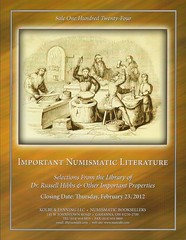 Kolbe & Fanning held their 124th mail-bid sale of numismatic literature on Thursday, February 23. The sale
featured material from the libraries of Dr. Russell Hibbs and a noted Pennsylvania specialist, as well as a
number of other consignments. A number of obscure and esoteric works were included, in addition to more standard
works on coinage from around the world.
Kolbe & Fanning held their 124th mail-bid sale of numismatic literature on Thursday, February 23. The sale
featured material from the libraries of Dr. Russell Hibbs and a noted Pennsylvania specialist, as well as a
number of other consignments. A number of obscure and esoteric works were included, in addition to more standard
works on coinage from around the world.
A few highlights follow:
A bidding war broke out over a remarkable 1792 newspaper featuring information on the political negotiations behind the establishment of the U.S. Mint (lot 843). The March 29, 1792 issue of the National Gazette, estimated at $300, sold to a determined bidder for $3162.50 (all prices given include the 15% buyers' premium).
Another item that received considerable attention was lot 574, the sole catalogue issued by Virgil Brand's Chicago Coin Company. This very scarce catalogue, in exceptional condition, sold for $1035 on a $300 estimate.
A complete set of the Asylum (lot 362), the quarterly journal of the Numismatic Bibliomania Society, brought $977.50 on a $600 estimate.
Charles Clay's extremely rare photographically illustrated 1860s works on Isle of Man coinage (lot 141), published in the Proceedings of the Manchester Numismatic Society, sold for $948.75 on a $500 estimate.
A scarce first-edition set of Henry Cohen's Description historique (lot 953) sold for $891.25 on a $450 estimate.
As has been seen in other recent sales, unusually rare, choice material is in considerable demand.
Kolbe & Fanning's next mail-bid sale will be held June 7. We are actively seeking rare and desirable numismatic works for outright purchase or for inclusion in our upcoming mail-bid or public auction sales. For more information, please contact David Fanning at df@numislit.com. For the firm's website, go to www.numislit.com, where the full prices realized list for the Feb. 23 sale is available.
David F. Fanning, Ph.D.
Kolbe & Fanning Numismatic Booksellers LLC
141 W. Johnstown Rd.
Gahanna, OH 43230
(614) 414-0855
Cell (614) 256-8915
Fax (614) 414-0860
df@numislit.com
www.numislit.com
NEW BOOK: COINAGE AND CURRENCY IN EIGHTEENTH CENTURY BRITAIN
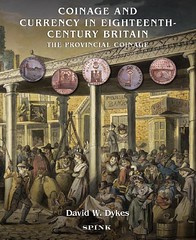 'Written by an expert in the field and drawing on recent research, this book aims to put Britain's 18th-century provincial token coinage into the context of the currency problems of the time. On the basis of a wide range of both documentary and secondary sources it examines its major manufacturers and their intentions, and through profiles of many of the issuers involved it sets out to give a living dimension to a bygone monetary phenomenon.'
'Written by an expert in the field and drawing on recent research, this book aims to put Britain's 18th-century provincial token coinage into the context of the currency problems of the time. On the basis of a wide range of both documentary and secondary sources it examines its major manufacturers and their intentions, and through profiles of many of the issuers involved it sets out to give a living dimension to a bygone monetary phenomenon.'
Full title: Coinage and Currency in Eighteenth Century Britain: The Provincial Coinage
Hardback; 400 pages, illustrated throughout in colour. 210 x 276 mm
PRICE £65.00
For enquiries and orders please contact Alex Smith on +44 (0) 20 7563 4046 or e-mail: books@spink.com. (Order ref: 04207)
BOOK REVIEW: WILD WORLD
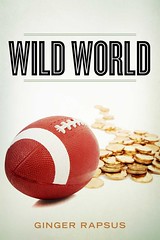 For the second time in a year I read a fiction e-book because its premise is coin-related. This time, I read Wild World by Ginger Rapsus. Rapsus is the author of United States Clad Coinage published in 1992 and is currently a columnist for Numismatic News. Her website says that she began writing fiction "a few years ago."
For the second time in a year I read a fiction e-book because its premise is coin-related. This time, I read Wild World by Ginger Rapsus. Rapsus is the author of United States Clad Coinage published in 1992 and is currently a columnist for Numismatic News. Her website says that she began writing fiction "a few years ago."
Wild World is the story about Stacey Morgan, a nurse's aide that works in a large Chicago hospital, who inherited an old silver dollar. Not being an expert in coins, Stacey researches the coin on the Internet and begins to realize that she has something special but not sure how special. The coin, an 1873 Seated Liberty Dollar, is something special because none exist except in the world of fiction writers.
After discussing the coin with her friend Peg, a nurse who works on the same hospital ward, Stacey plans to go to a coin show to try to figure out what her coin was worth. The story is woven between Stacey dreaming about a better life away from the grind of being an aide at the hospital and how the grind at the hospital is driving her to find out more about the coin.
Not knowing how to approach the coin community at the coin show, Stacey brings Peg for moral support. Both being young women also think about meeting someone interesting at the coin show but Stacey is more interested in finding out the value of her coin. They playfully play their "what if" scenarios as they ride the train to the show.
As a story, Wild World flows well after the first two pages, which I have described as a "word salad" trying to say too much to set the scene. The story paints a good mental picture that would help both those experienced with coin shows and those who have attended large conferences to imagine how the scene would feel.
Wild World is only available in e-book form and available from the popular digital bookstores for $2.99, which is a great price. One of those stores described the book as being 150 pages. While what constitutes a page is different between e-readers, it does come in shorter than many other books I have downloaded making it a comfortable length even for someone who prefers non-fiction, like me. The story is well developed and only part of the ending is predictable. Since this is not a numismatic book but a work of fiction surrounding a numismatic setting, I am giving Wild World a specimen grade of SP67 because the first few pages need to be tightened a bit and the end should have been less predictable. Wild World is underpriced for the quality of the writing and should be on your reading list.
To read the complete article, see: E-BOOK REVIEW: Wild World (coinsblog.blogspot.com/2012/02/e-book-review-wild-world.html)
THE BOOK BAZARRE
CAPPING LIBERTY: NUMISMATIC ICONOGRAPHY FOR THE NEW AMERICAN REPUBLIC
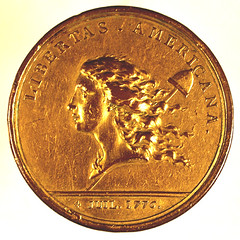 Capping Liberty:
The Invention of a Numismatic Iconography for the New American Republic
Capping Liberty:
The Invention of a Numismatic Iconography for the New American Republic
An Exhibition of Coins, Medals, Banknotes, and Related Books, Manuscripts, and Graphic Arts from Princeton University Collections
Milberg Gallery, Firestone Library, March 3, 2012, to July 8, 2012
When the founders of the American Republic declared independence from Great Britain on July 4, 1776, one of the major tasks they took on was the creation of a coinage for the new nation. There were few precedents to guide them in choosing specific images to represent the ideals of their republican form of government as most existing coinage bore the image of a monarch. The leading figures in the process of selecting the numismatic imagery of the American Republic were Benjamin Franklin, Thomas Jefferson, and George Washington, each of whom made contributions that reflected personal background, attitudes, and ideals.
Following a rancorous dispute between the Senate and the House of Representatives, the ultimate choice for the main image for the new coinage was "an impression emblematic of Liberty," which took the form of the head of a beautiful woman, sometimes accompanied by a cap derived from classical attributes of the Roman goddess Libertas. Together with the complementary attributes of an eagle and a wreath, this symbol came to exemplify the United States of America.
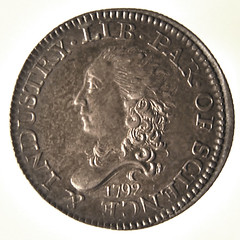
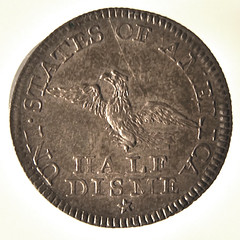
Silver half disme, 1792.
The rich resources of Princeton University Library's Department of Rare Books and Special Collections serve as the basis of an exhibition entitled "Capping Liberty," which illustrates the search for imagery and the selection and adoption of symbols for a national coinage. "The star of the show will undoubtedly be the Princeton specimen of the 1792 'half disme'," predicts Alan Stahl, the exhibition's curator. This is a superb example of the first coin minted by the United States government under the Constitution. Delays in passing the Mint Act of 1792 left little time to strike coins that year, so a very small issue of half dismes (the old French spelling was used on the piece) was minted in a temporary facility, reputedly from silver supplied by George Washington for the purpose.
Fewer than 2,000 examples are believed to have been struck. The Princeton specimen was purchased by Charles A. Cass, Class of 1904, from an auction in 1917, by Thomas Elder where it was described as "the finest known specimen of this exceedingly rare coin." It came to Princeton with the impressive Cass numismatic collection by bequest in 1958. The specimen has been characterized by Roger Siboni, president of the American Numismatic Society, as "perhaps the finest, or one of the finest 1792 half dismes in existence" in an article in Coin World (Sept. 1, 2008).
Other important coins from the Princeton University Numismatic Collection in the exhibition are four issues of the seventeenth-century Massachusetts silver shilling coinage, two examples of the tin "Continental dollar" patterns of 1776, and a 1794 (14 star) silver dollar.
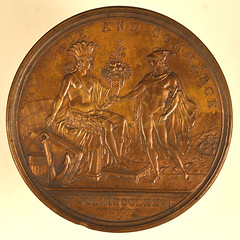
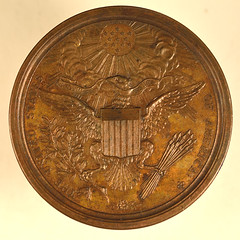
Augustin Dupré, Diplomatic Medal, bronze, 1791.
The "poster piece" of the exhibition is the gilt bronze striking of Augustin Dupré's 1783 Libertas Americana medal, a gift of Rodman Wanamaker, Class of 1886, which is believed it have been the basis for the depiction of Liberty on the early United States coinage. It is accompanied by a selection of ancient coins that inspired it, including a Sicilian dekadrachm and a series of denarii of the Roman Republic and sestertii of the Empire that show the goddess Libertas and her distinctive cap. Other important medals in the exhibition are an original bronze striking of Dupré's Diplomatic Medal of 1791 (one of only three known), a gift of the scholar of ancient and American coinage Cornelius Vermeule III, and a hand-engraved medal believed to have been given to Henry "Light-Horse Harry" Lee (Princeton Class of 1773). Also on display are three unique plaster moulds made by Jean-Baptiste Nini as preparatory models for his famous terra-cotta medallions of Benjamin Franklin.
Complementing the coins and medals from the Numismatic Collection are many items from other divisions of Princeton's Special Collection, including books formerly in the libraries of Benjamin Franklin, George Washington, and Thomas Jefferson. Among the depictions of Liberty from colonial publications is the portrait of John Hancock engraved in 1774 by Paul Revere, where the patriot is flanked by a knight with a copy of the Magna Charta and Liberty with her cap. In manuscript letters George Washington voices support for Jefferson's "Propositions Respecting the Coinage of Gold, Silver and Copper," and John Adams asks Mint Director Benjamin Rush (Princeton Class of 1760) for examples of United States coinage for his son John Quincy Adams to send to Russia. A 1778 print attributed to the painter Jean-Honoré Fragonard depicts Benjamin Franklin crowned by the goddess Liberty, and a large piece of Toile de Jouy fabric printed around 1785 has the image of George Washington in a gold chariot drawn by cheetahs.
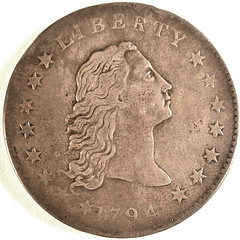
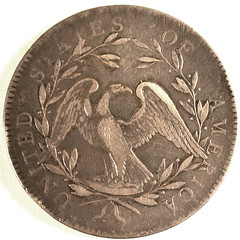
Silver dollar, 1794.
On Sunday, May 6, the noted scholar of American colonial coinage, Louis Jordan, of the University of Notre Dame, will give a public lecture entitled "Transformations in Numismatic Iconography during the American Revolution" at 4 p.m. in 101 McCormick Hall on the Princeton campus. The lecture will be preceded at 2:30 by a curatorial tour of the exhibition in Firestone Library by Alan M. Stahl, Princeton's Curator of Numismatics. A reception in Firestone Library will follow the lecture. Additional curatorial tours will be held on Sunday, March 25, and Thursday, May 31, both at 2:30 p.m. The exhibition and its associated events are free and open to the public.
A website devoted to the exhibition, including high-resolution images of both sides of all coins on display and images from the books, manuscripts, and graphic arts, is online at rbsc.princeton.edu/capping-liberty and will remain on the site after the close of the exhibition.
"Capping Liberty" runs from March 3, 2012, through July 8, 2012, in the Leonard L. Milberg Gallery of Firestone Library, Princeton University. Hours are Monday through Friday, 9 a.m. to 5 p.m., Saturday and Sunday, noon to 5 p.m., closed holidays. Further information can be obtained from Alan Stahl, Curator of Numismatics, at astahl@princeton.edu or (609) 258-9127.
SAVE A BOOK! AVOID SHIPPING DAMAGE
You spend weeks or years hunting for a particular book or catalogue. Finally, you locate the item, close the deal, and await delivery. If you are a true bibliophile (manic), you have been tracking your shipment online by the hour. You probably have a post office box or alternative shipping location. You have a "method" for bringing more books into your home since you are unable to explain why you need additional volumes. You are ready !!!!!!!!!!!!!!!! Finally, the anticipated volume arrives.
But ......it arrives in a Postal Service "Damage Bag" reading:
Dear Postal Customer:
Although postal employees carefully handle each piece of mail during processing, items sometimes are damaged. This usually occurs as mail is processed through our automated equipment.
When damage does occur, as it did with this piece of mail, the item is sent to a special unit where it is enclosed in a plastic bag for protection during the remainder of its delivery.
We are working to improve our processing methods to prevent mail damage in the future. Meanwhile, we sincerely regret any inconvenience or delay you may have experienced in receiving this piece of mail.
We sincerely regret any inconvenience you may have experienced.
PLANT MANAGER
To all Shippers of Numismatic Literature:
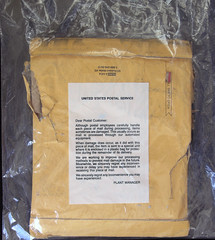 I highly encourage you to read John Bergman's Asylum article on packing books. John's fastidious packing was near flawless. And .... a small incremental effort in safe packing and shipping of books will protect the material and avoid a let down by the receiving party. Take a look at the attached photo The front of the package was even worse, but the shipper shall remain anonymous.
I highly encourage you to read John Bergman's Asylum article on packing books. John's fastidious packing was near flawless. And .... a small incremental effort in safe packing and shipping of books will protect the material and avoid a let down by the receiving party. Take a look at the attached photo The front of the package was even worse, but the shipper shall remain anonymous.
To the credit of the shipper (a non-numismatic book dealer), I received a 100% refund including postage. I offered to send photos or return the item in a box, but the seller declined further information requirements.
To read John Bergman's article, see: How to Pack Books (www.coinbooks.org/club_nbs_how_to_pack_books.html)
QUIZ QUESTION: WHO IS THIS MYSTERY NUMISMATIST?
Pete Smith writes:
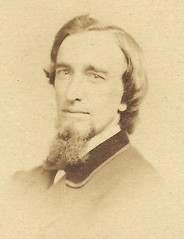 Attached, for your consideration, is the photo of a mystery numismatist.
I offer two clues to his identity:
Attached, for your consideration, is the photo of a mystery numismatist.
I offer two clues to his identity:
1. The date 1864 is written in pencil on the back of the print.
2. His name appears in Consecutive Issue 87 of The Asylum.
I will provide the identity next week along with a follow-up question.
NOTES FROM E-SYLUM READERS: FEBRUARY 26, 2012
On Fred Berson's TAMS Article
Ken Berger writes:
In last week's E-Sylum, Ron Abler stated that he "recently ran across a dark Xerox copy of a 1876 article in TAMS written by Fred Berson on U.S. Centennial Die Trials. I would very much like to ask him some questions. TAMS has no record of him after 1977." Assuming Berson was at least 20 years old when he wrote the article, I'd also like to ask him a question. Specifically, "How did he manage to live to such a ripe old age?"
To read the earlier E-Sylum article, see: NOTES FROM E-SYLUM READERS: FEBRUARY 19, 2012: Fred Berson Sought (www.coinbooks.org/esylum_v15n08a10.html)
Bert Bressett
Ken Bressett writes:
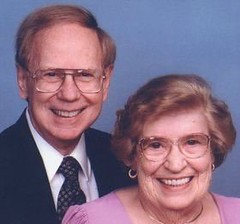 Thanks for the splendid coverage you gave to Bert's obituaries in last week's E-Sylum.
It was superb, in true Wilson style. My heartfelt thanks go out to everyone who have been so thoughtful in sending their condolences, comments, prayers and kind wishes.
Thanks for the splendid coverage you gave to Bert's obituaries in last week's E-Sylum.
It was superb, in true Wilson style. My heartfelt thanks go out to everyone who have been so thoughtful in sending their condolences, comments, prayers and kind wishes.
To read the earlier E-Sylum article, see: BERT BRESSETT, 1925-2012 (www.coinbooks.org/esylum_v15n08a05.html)
Hans Schulman and Herman Steinberg
Harry Waterson pointed out this eBay lot of two ANA medals. The sale ended February 24th, but perhaps this will stimulate some reader responses. From the auction description:
One medal reads: Hans M.F. Schulman New York, N.Y on name tag and medal read 1969 Annual Convention Philadelphia 78th Anniversary American Numismatic Association. Other medal reads: Herman Steinberg Brooklyn N.Y. 80TH Anniversary Convention 1971 Washington D.C. Our Nation's Capital, American Numismatic Association

HELENA BONHAM CARTER RECEIVES CBE MEDAL
 For both women it was a meeting that could have provoked the strangest feeling of deja vu.
There on the dais was the Queen. And in front of her, her own mother - or rather, Helena Bonham Carter, who played the Queen Mother in the hit film The King's Speech.
For both women it was a meeting that could have provoked the strangest feeling of deja vu.
There on the dais was the Queen. And in front of her, her own mother - or rather, Helena Bonham Carter, who played the Queen Mother in the hit film The King's Speech.
The 45-year-old, who won the best actress Bafta for her role opposite Colin Firth who played the Queen's father George VI, was at Buckingham Palace yesterday to collect her CBE.
It is understood that the Queen has seen the film, about the king's battle to overcome his speech impediment, and enjoyed the actress's portrayal of her late mother.
Miss Bonham Carter was accompanied to the Palace by her equally wild-haired partner, American film director Tim Burton, their children Billy Ray, eight, and four-year-old Nell, and her mother Elena.
To read the complete article, see:
'Very, very special': Helena picks up a CBE from her 'daughter'
(www.dailymail.co.uk/femail/article-2104866/Helena-Bonham-Carter
-picks-CBE-daughter-Queen.html)
CAMEO INCRUSTRATIONS AND PLATINUM USE IN GLASSMAKING
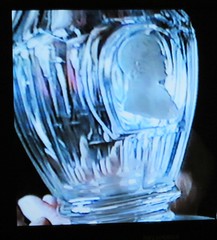 We recently published a plea from a descendant of Adam Eckfeldt seeking a lost glass pitcher bearing the image of Eckfeldt made from a medal with his portrait. Last week Dick Johnson responded with an account of how medals were used to make design (called "incrustrations" in glass. The descendant, an E-Sylum subscriber, writes:
We recently published a plea from a descendant of Adam Eckfeldt seeking a lost glass pitcher bearing the image of Eckfeldt made from a medal with his portrait. Last week Dick Johnson responded with an account of how medals were used to make design (called "incrustrations" in glass. The descendant, an E-Sylum subscriber, writes:
Dick Johnson's article was most interesting to me. Whenever my mother discussed the pitcher, she would say she wasn't sure how the bust was put on, but she thought she had heard the process involved platinum. She would have heard this from her father, a trained chemist, or her grandfather Jacob B. Eckfeldt, the assayer. No chemist myself (nor was my mother - we didn't inherit the scientific genes!), I am curious if platinum could have been the material used to treat the clay in this case, just to corroborate my mother's recollection.
So I put the question to Dick Johnson, who writes:
Mother was partly right. Platinum is widely used in glass making. But it was not necessary for making cameo incrustations.
I am not an expert in glassmaking (my expertise is the relief that was molded in the glass). It appears from reading the literature that the molds for glass objects are often made of platinum for several characteristics of the metal. It can withstand the heat necessary for containing the molten glass, it can be formed to any shape -- and best of all -- the platinum metal can be reused.
It appears platinum can be used for what I call "long press runs." (I don't know the equivalent term for glassmaking.) Let's just say a large number molded glass objects can be made from the same mold, used over and over.
I don't believe this was the case for the Eckfeldt pitcher. Particularly since there are so few of these, a great quantity apparently were not made.
To read more click on this article:
Don't discredit what mother said. Just recognize it was not necessary for her pitcher.
On a related note, Joel Orosz adds:
Dick Johnson's responds was highly informative but contained an error. Adam Eckfeldt was not the first Chief Coiner. Henry Voigt was the first Chief Coiner, 1792-1814. Adam Eckfeldt was the second, 1814-1839.
To read the earlier E-Sylum articles, see:
CAMEO INCRUSTATIONS AND THE ADAM ECKFELDT PITCHER
(www.coinbooks.org/esylum_v15n08a06.html)
MISSING ADAM ECKFELDT PITCHER SOUGHT
(www.coinbooks.org/esylum_v15n07a08.html)
THE BOOK BAZARRE
THE CARNEGIE HERO TITANIC MEMORIAL
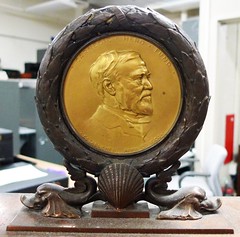
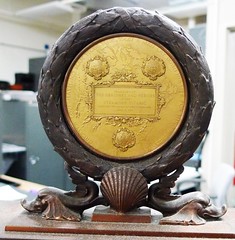
Within two weeks of the sinking of the Titanic in the North Atlantic on April 15, 1912 - one hundred years ago next month - the president of the Carnegie Hero Fund Commission, Charles L. Taylor, appointed a committee of three to explore what action the Commission might take to recognize acts of heroism performed in the rescue of the tragedy's survivors.
Providing recognition for individual heroes was not within the scope of the eight-year-old Hero Fund, whose awarding requirements limited consideration to acts of heroism occurring "in the United States of America, the Dominion of Canada, the Colony of Newfoundland, or the waters thereof." Four hundred miles off the Great Banks of Newfoundland could not be considered "the waters thereof."
The special committee reported on their thinking to the Hero Fund's standing Executive Committee on April 30. From the minutes of that meeting: "A general discussion followed as to whether any action should be taken...and many views were expressed on both sides of the question. Finally, a motion was offered that the Executive Committee, having been authorized to act for the Commission in this matter, decide to recognize the acts of heroism performed by members of the ship's company of the S.S. Titanic. Motion carried." The motion, which was later adopted by the full Commission, is as follows:
"WHEREAS, the Carnegie Hero Fund Commission, under the terms of its foundation, being unable adequately to recognize the sublime self-sacrifice displayed by passengers, officers, and crew of the Steamship Titanic, lost off the Banks of Newfoundland, April 15, 1912, nevertheless desires to record its admiration for their acts of heroism, and to commemorate these great and inspiring examples of exalted womanhood and manhood; therefore be it
"RESOLVED, that a gold medal be issued by this Commission, appropriately inscribed to the heroines and heroes of the Steamship Titanic and deposited in the United States National Museum at Washington, and that a record thereof be placed on the Roll of Honor of the Carnegie Hero Fund Commission, as a lasting memorial of those whose chivalrous conduct and self-sacrifice have profoundly moved the civilized world."
The gold medal was inscribed, "In memory of the heroines and heroes of the Steamship Titanic, lost off the Banks of Newfoundland, April 15, 1912." It was mounted on a bronze plaque that was designed and made by J.E. Caldwell & Co. of Philadelphia, which a few years earlier designed the Carnegie Medal and was awarded the contract to produce it. According to the Hero Fund's records, the cost of the memorial was $575, including the $275 cost of the gold medal.With gold prices today ($1,663 as of this writing) about 80 times the price in 1912 ($20.67 at year-end), a replacement medal weighing nine troy ounces would cost $15,000.
The memorial's design was endorsed by Charles D. Walcott of the Smithsonian Institution's U.S. National Museum, Washington, D.C., in a visit to the Hero Fund's offices in 1912. He acknowledged receipt of the memorial in a letter dated Dec. 19: "The medal, with the tablet and an appropriate label, will be placed on exhibition at once in the Hall of History of the National Museum where it will constitute a permanent monument to the self-sacrificing chivalry exhibited by those who voluntarily yielded up their lives for others."
Dr. Paul F. Johnston, present curator of maritime history for the National Museum of American History, recently informed that although the museum has Titanic material on permanent display in its maritime hall, it is not planning anything special to mark the centennial of the Titanic's sinking and that the Hero Fund's memorial is not available for public viewing.

For more information on the Carnegie Hero Fund Commission, see: http://carnegiehero.org/
GOLD DUST AS MEDIUM OF EXCHANGE IN 19TH CENTURY IDAHO
In Idaho Territory in the 1860s and 1870s, gold dust, extracted from sand and gravel by the use of water, was a common medium of exchange, and it was trusted more than U.S. paper currency.
Thomas Donaldson, who held several important government positions in Idaho from 1869, when he arrived in Boise as register of the U.S. Land Office, devotes a section of his delightful book "Idaho of Yesterday" to money and its fluctuation.
He notes that in 1868 the Idaho Supreme Court tried to stabilize the territory's monetary system, but in spite of it, national currency, commonly called "green backs," continued to be unstable, and apt to have varying values daily.
Donaldson recalled: "Gold and silver were called 'coin.' Gold dust was also a legal tender and was receivable at $10 and $16 the ounce. The Owyhee dust, owing to its debasement with silver, was receivable at the lower price. Bullion was taken at par. Currency was taken at 80, 78, 76, or 75 cents on the dollar as against gold coin. ... From 1863 to 1868, taxes were collectable in gold coin or its equivalent."
If you find this confusing, think what it must have been like for merchants and their customers. Donaldson describes how the process of handling gold dust worked: "Our bankers, merchants, hotel keepers, and traders always kept at hand a pair of small brass balances, or scales, with necessary weights and brass or copper pans. ... These balances were known as dust scales and were for weighing gold dust, the gleanings of placer mining. The scales usually rested upon a piece of carpet. I saw one carpet strip, not more than fifteen inches square, yield nearly one hundred dollars from dust which had fallen or blown from the pans in the course of a year. Customers usually presented their dust in buckskin bags 6 or 8 inches long by 2 in diameter, with a drawstring at one end. These sacks were made in California and sold as a regular commodity.
"The buyer or weigher turned the dust into the pans of the scales and then blew smartly on the mass to weed out all valueless light stuff. At the same time, he juggled the pans so as to free all parts of the mass. Dishonest buyers were very apt to blow much harder than was warranted in order to scatter bits of gold into the waste heap and so cheat the seller."
There were many ways to cheat when dealing in gold dust, and enterprising crooks knew than all, from outright counterfeiting to mixing iron and lead particles with the real thing.
Mike Dakis, who researched the subject in depth in the 1960s, wrote "The prevalence of bogus gold dust eventually caused merchants to raise the price of their goods by twenty-five to fifty percent. Some saloon owners compensated for adulterated dust by providing their scales with heavier weights. The honest purchaser, who refused to adulterate his gold dust, saw the value of his earnings rapidly dwindle. In addition to the possibility of being cheated by false weights, he was forced to purchase goods at an elevated price."
Fake or adulterated gold dust was so common in the 1860s that it was called simply "bogus." Legend has it that Bogus Basin takes it name from a band of counterfeiters who operated from there.
To read the complete article, see:
Idaho History: Gold dust was once a common medium of exchange
(www.idahostatesman.com/2012/02/19/2000927/gold-dust
-was-once-a-common-medium.html)
MEDAL SERIES PRODUCER TOIVO JOHNSON
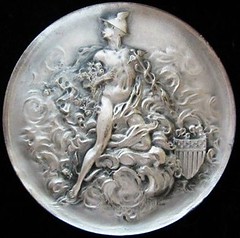
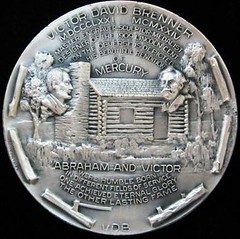
Web site visitor Raymond Gerrity writes:
I recently purchased a very large silver medallion designed by Toivo Johnson. The medallion seems to pay tribute to Victor David Brenner. It appears to have been made in 1961 at a place called The Metal Arts Company, Rochester, New York. It has the number 486 on the rim at 12 O Clock.
Can you tell me anything about this medal? Where can I find more information about Toivo Johnson & his created works? Does the Metal Arts Company still produce medals?
The issuer was a Maine numismatist, Toivo Johnson (1913-1973) and no relation to the present writer. In 1961 he developed the idea to issue a series of medals to honor coin engravers. His idea was to reproduce the artist's most popular design on one side and a tribute to the artist on the other.
He first approached William Louth, president of Medallic Art Company. He came to New York and told Bill of his plan. He wanted Medallic Art to strike the medals. Bill liked the idea of honoring coin designers, but not reproducing the coin design. This was still the era when exact coin images were verboten -- illegal -- and he rejected that concept.
He suggested to Toivo to have the artist's portrait on one side and the other a tribute to the artists' numismatic creations. He could have a top artist create the models. Toivo was firm in his mind, that was not what he wanted. The two exchanged words. Toivo left with the rejection ringing in his ears. He would show that Bill Louth what he wanted. So he went to Medallic Art's competitor, Metal Arts in Rochester, New York.
Years later Toivo Johnson went back to Metal Arts company and had two more medals made, here again with dies cut by Schabel, the American Freedom Medal and the Maine Sesquicentennial Medal. Both of these were issued in 1970.
I forwarded his questions to Dick Johnson, who writes:
The series of six medals honoring coin engravers -- five Americas and one ancient -- is a textbook example of what NOT to do.
In 1961 Toivo Johnson from Maine came to Medallic Art with an idea for this series of medals. Admirable idea, but flawed concept. He approached company president Bill Louth with his plan. Bill rejected the concept of replicating an existing design by each engraver. Instead he suggested preparing a new model in tribute to the artist. Incensed that his concept was not readily accepted, Toivo left. He rejected Louth's suggestion, steadfast in his own ideas.
That same year four numismatists from Ohio came to Medallic Art with a plan for a series of medals. (They wanted to issue medals in similar size to commemorative half dollars recently discontinued by the U.S. Mint.) They wanted to honor U.S. presidents. They listened to the comments of Bill Louth who suggested high-relief medals in the size they wanted. Further he put them in touch with a seasoned sculptor who could create exactly what they envisioned (Ralph Menconi).
Louth offered further suggestions in design, metal content, quantity to strike, and marketing. That group of four numismatists became Presidential Art Medals, which became wildly successful. Not only did the presidential series sell well, they went on the create six other series -- for states, signers of the Declaration of Independence, World War II events on their 25th anniversaries, great religions, space explorations, and aviation.
All seven series were struck by Medallic Art working closely with the four entrepreneurs. They had listened -- originally and continuously -- to some seasoned medallic advice which served them well. This in contrast to a fixed idea in the mind of Toivo Johnson, who turned instead, to Metal Arts in Rochester to strike his medals.
Metal Arts did produce the medals Toivo wanted. But these were not from sculptor's models (but by tracer engraving by a craftsman, not a fine artist). Also, someone chose a quantity to be struck far in excess of what the market could bear.
Twenty years later, Toivo's son contacted me. He had inherited a vast quantity of these medals after his father's death. This overhang quantity continues to influence secondary market price, as these remained difficult to sell. I couldn't be of much help in marketing these for him. In contrast, all Presidential Art Medals enjoy a vibrant secondary market appeal and value.
Toivo did everything wrong.
PS: Metal Arts is still in business, in janitorial services.
To read the earlier E-Sylum article, see: TOIVO JOHNSON'S COIN DESIGNER MEDAL SERIES (www.coinbooks.org/esylum_v13n27a15.html)
VIDEO HIGHLIGHTS CINCINNATI'S OSBORNE COINAGE
There aren't many businesses that have been around since Andrew Jackson was President, but Cincinnati is home to one of them. Osborne Coinage has been minting coins, medallions and tokens for nearly 180 years, and they're still cranking them out today. They are the oldest private mint in America and they showed Local 12 News reporter Joe Webb today why they are a place that is truly "So Cincinnati."
If you like the sound of coins jingling, Osborne Coinage's Camp Washington shop is your kind of place. Hundreds of millions of brass tokens, medallions and coins clink out of there each year. Most for the amusement industry. "Somewhat still for the casino industry but in the amusement side it's really any place where you have a placeholder....worth one play... like at the batting cage.. we do millions and millions of tokens for that industry."
More than 700 car wash tokens a minute were getting stamped by one machine this morning. If you've ever been to Chuck E. Cheese, every one of those tokens was made at Osborne Coinage. "Every Chuck E. Cheese. That's correct."
In 177 years, they've had more high brow clients including several Presidents. Before there were bumpers for bumper stickers, candidates handed out campaign coins. Osborne made them. "For all the Presidents, Abraham Lincoln and George McClellan who he ran against in 1864, we did tokens for both of them which they used at stops, railroad stops during the campaign."
Today, miles of brass coil is cut, washed and dried into blanks that are eventually stamped with precision machines. Despite the advent of computer controls and computer designs, there's still a lot of artistry in sculpting the dies. All of it is done at Osborne's Coinage.
In 1864, there was a controversy over whether President Lincoln should shave his beard or keep it. Osborne coinage wasn't sure if their campaign coin should have him bearded or clean shaven, so they made one of each.
To read the complete article, see:
So Cincinnati: Osborne Coinage
(www.local12.com/news/local/story/So-Cincinnati-Osborne
-Coinage/I6mIoFHzD0-WCR6NfaoObg.cspx)
1860 LINCOLN CAMPAIGN BUTTON FOUND IN MINNESOTA
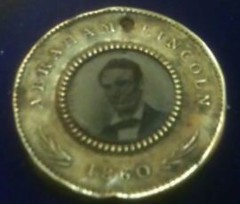 President's Day had a special meaning at an antique shop in Minnesota. A rare presidential coin got a great deal of attention.
President's Day had a special meaning at an antique shop in Minnesota. A rare presidential coin got a great deal of attention.
"I've always had an interest a fascination with Abraham Lincoln," says Bryce Stensall. It's no coincidence that Stensall also resembles the nation's 16th president. A costume historical interpreter, he'll make the rounds in town sharing Lincoln's story.
Last fall, they found a presidential coin tucked away in the bottom of a box of costume jewelry. It's dated 1860 and on one side is the portrait of a beardless President Lincoln and on the other his Vice President Hannibal Hamlin. Rob says, "When people actually can touch that kind of piece of history it just sends tingles up your spine, Abe Lincoln could have actually passed this thing out."
The thinking is it was once used much like campaign buttons are used today and 152 years later, Rob says, "It's very exciting it's also very humbling I knew that I get to hold it in my hand."
To read the complete article, see:
Antique shop owners find rare Lincoln coin
(www.todaysthv.com/news/article/197549/288/Antique-shop-owners
-find-rare-Lincoln-coin)
Alan V. Weinberg writes:
I'm looking at the APIC Keynoter Ferrotype Issue of Fall 2007. Authored by Dr Edmund B. Sullivan (God of political ephemera), he states Douglas Maltby of Waterbury CT patented the process of ferrotypes in brass frames in 1860 . Patenting is one thing, producing them en masse is another and the assumption is then that he licensed the process to Scovill of Waterbury who was in business then and produced many well-struck tokens. In 1864 John Gault patented his distinctive ferrotype case process as he did the encased postage patent.
It is the center mini-tintype that is important as to quality, not the brass shell rim. NGC slabs these but grades them on the basis of the condition of the brass rim, not the quality of the photographic emulsion in the center.

MORE ON ROBERT HECHT
But another thing shall not be forgotten: the Clain-Stefanellis owe to Bob Hecht their rescue to secure America. I allege part of my obituary of Elvira Clain-Stefanelli based on a longer interview with her:
"After the war the Clain-Stefanellis moved to Rome taking employment together at Santamaria company. ... But even Italy did not offer a secure home in the long run. America and Russia had agreed that Russian citizens had to return home. The area where Vladimir was born had become part of Russia in the meanwhile. Thus there was danger of being deported."
With the help of a clever Italian clerk the family Klein, whose name virtually asked for investigation, became the family Clain-Stefanelli. "Under this name both Clain-Stefanellis left for the United States of America with the aid of their American friend Bob Hecht."
Bob Hecht died being a representative of a passed epoch of antiquities trade. Characters like him did not contribute to this trade sector's good reputation. Nevertheless we who have been born later, should beware of judging them hastily. Those were other times with other conceptions and ideals. Our current ethical and moral claims cannot be transferred to the past. Whoever acts in this way forgets that even human conceptions of right and wrong are subjected to a continuous change.
To read the complete article, see: Bob Hecht (1919-2012) (www.coinsweekly.com/en/page/4?&id=1041)
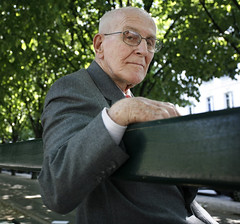 Robert E. Hecht, an American expatriate antiquities dealer who skipped in and out of trouble for much of his career, weathering accusations that he trafficked in illicit artifacts, including a 2,500-year-old Greek vase that he sold for more than $1 million to the Metropolitan Museum of Art, died on Wednesday at his home in Paris. He was 92.
Robert E. Hecht, an American expatriate antiquities dealer who skipped in and out of trouble for much of his career, weathering accusations that he trafficked in illicit artifacts, including a 2,500-year-old Greek vase that he sold for more than $1 million to the Metropolitan Museum of Art, died on Wednesday at his home in Paris. He was 92.
An urbane world traveler with an often coy and seemingly imperturbable manner, Mr. Hecht began running afoul of the authorities in the early 1960s, when he was accused of dealing in looted art in Italy and smuggling coins out of Turkey.
"He was, if not exonerated, never proven guilty," Elizabeth Hecht said in an interview on Thursday. "In 13 years they couldn't find anything to pin on him. So I say he was innocent."
"Bob was always someone who could let things fall off his shoulders, like a duck," Elizabeth Hecht said when asked how her husband had borne such persistent and intense scrutiny by the authorities. "What he didn't want to know about, he was able to ignore. He was very good at that."
To read the complete article, see:
Robert Hecht, Antiquities Dealer, Dies at 92
(www.nytimes.com/2012/02/10/arts/design/robert-hecht-antiquities
-dealer-dies-at-92.html)
MANHATTAN BEACH CENTENNIAL MEDALS ISSUED
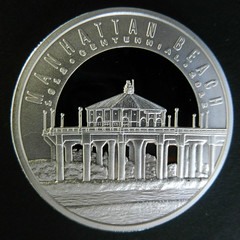 Featured on one side of the coin is the Manhattan Beach pier - for which he used a self-shot photograph - and on the other side, a surfer, volleyball player and seagull next to the ocean. "I wanted to capture all of the most of Manhattan Beach as I could on the coin," he said.
Featured on one side of the coin is the Manhattan Beach pier - for which he used a self-shot photograph - and on the other side, a surfer, volleyball player and seagull next to the ocean. "I wanted to capture all of the most of Manhattan Beach as I could on the coin," he said.
Gill spent about $1,500 to create the dies and another $3,000 to buy the silver and brass. Describing the project as a labor of love, Gill is overjoyed about how the coin turned out. "I had very high expectations and they were exceeded," he said. "It's a dream come true, really."
Residents can buy the silver coins for $85 and the brass coins for $20. So far, Gill has sold about 40 of the silver and 20 of the brass. Proceeds will be shared with the centennial committee.
At the centennial carnival at the Manhattan Village mall last month, Mayor Nick Tell, dressed in traditional garb from the early 1900s, used Gill's coin to reenact the legendary coin flip that helped name the town.
Two landowners, George Peck and John Merrill, couldn't decide between "Shore Acres" and "Manhattan" - a coin toss settled the dispute. Of course, Manhattan prevailed. "Beach" was added to the name in 1927 to distinguish the city from other Manhattans around the country.
The Manhattan Beach Fire Department will use Gill's coin design for a pin to wear on fire fighter badges. "They'll wear it for a whole year," Gill said.
"It's a really cool coin," said Mayor Nick Tell. "I think it's going to be a great memento."
To purchase a coin, visit www.MB100coin.com.
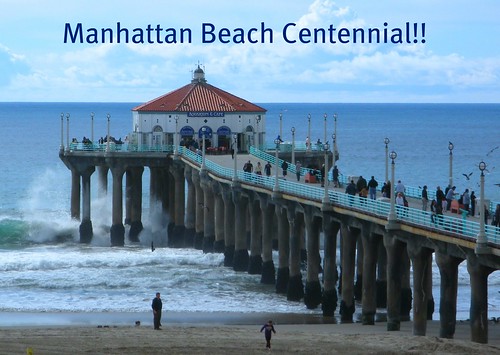
To read the complete article, see: Resident designs Manhattan Beach centennial coin (www.easyreadernews.com/46496/manhattan-beach-centennial-coin/)
FEATURED WEB PAGE: HISTORY OF THE SHEKEL
This week's Featured Web Page is an article titled Requiem for the Shekel. Published on the eve of the fourth change in the name of Israel's currency, it provides a lengthy history of the Shekel.In the beginning there was the shekel: a unit of measurement used for weighing metals in biblical-era Israel, and later for weighing food, before the invention of coins. Eventually that shekel became the name of a currency used in and around ancient Israel, made from silver or gold, and varying in size and weight depending on the region.
The Tyrian shekel, considered purer than the Roman shekel, was also used for the tax that all Jews paid annually during the Second Temple period in order to pay for sacrifices. It was dubbed "the half shekel." Although it was issued in Israel, it bore Roman images to make it clear that the Jews were not autonomous.
During the Bar Kochba Revolt, the rebels reminted Roman coins with the slogans and symbols of the revolt. One of them was the Bar Kochba shekel.
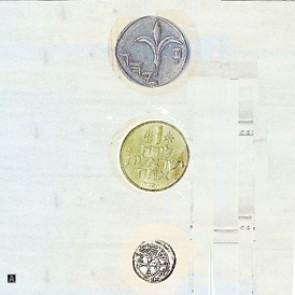
www.haaretz.com/weekend/magazine-
requiem-for-the-shekel-1.414590
